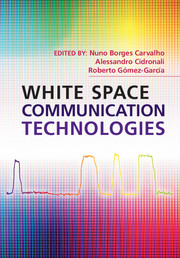Book contents
- Frontmatter
- Contents
- List of contributors
- Preface
- List of abbreviations
- Part I White space technology signal processing and digital design
- Part II Adaptable receivers for white space technologies
- Part III Adaptable transceivers for white space technologies
- 7 White spaces exploration using FPGA-based all-digital transmitters
- 8 Interference active cancelation techniques for agile transceivers
- 9 Highly efficient transmitter architectures
- Index
- References
7 - White spaces exploration using FPGA-based all-digital transmitters
from Part III - Adaptable transceivers for white space technologies
Published online by Cambridge University Press: 05 October 2014
- Frontmatter
- Contents
- List of contributors
- Preface
- List of abbreviations
- Part I White space technology signal processing and digital design
- Part II Adaptable receivers for white space technologies
- Part III Adaptable transceivers for white space technologies
- 7 White spaces exploration using FPGA-based all-digital transmitters
- 8 Interference active cancelation techniques for agile transceivers
- 9 Highly efficient transmitter architectures
- Index
- References
Summary
Introduction
The unprecedented attention given to wireless communications over recent years and even more recently to the exploration of the TV white spaces fosters the proliferation of new wireless standards operating at different frequencies, using dissimilar coding and modulation schemes, and targeted for different ends. Such vast proliferation pushes additional research effort towards the development of new flexible radios, capable of adapting to different communication scenarios.
In this sense, the idea of having a very flexible transmitter built essentially upon digital hardware is not new. However, the truth is that implementing such radios for real world communication is a challenging task, where a few key limitations are still preventing wider adoption of this concept. This chapter aims to address some of these limitations by presenting and discussing innovative all-digital transmitter architectures with inherent higher flexibility and integration, suitable for white spaces exploration, and where improving important features, such as usable bandwidth, frequency tuning, multi-channel operation, and coding efficiency (ηc), will also be addressed.
Scope and motivation
One characteristic that is shared across typical all-digital transmitter architectures is the use of a pulsed representation of the desired signal combined with a switched-mode power amplifier (SMPA). This approach was believed for a while to be a possible candidate for enabling the development of compact and highly energy-efficient RF transmitters [1], [2], [3].
The exponential use of wireless devices leads to a further use of a common resource, the electromagnetic spectrum.
- Type
- Chapter
- Information
- White Space Communication Technologies , pp. 199 - 230Publisher: Cambridge University PressPrint publication year: 2014



